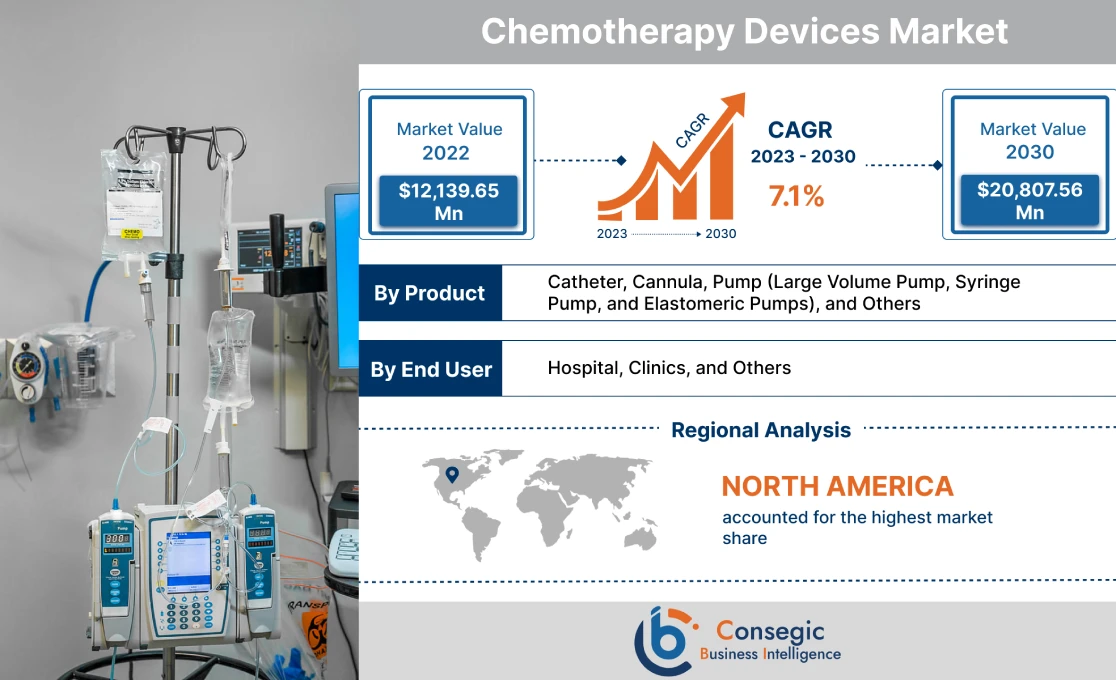Chemotherapy Devices Market Size :
Consegic Business Intelligence analyzes that the Chemotherapy Devices market size is growing with a CAGR of 7.1% during the forecast period (2023-2030), and the market is projected to be valued at 20,807.56 Million by 2030 from 12,139.65 Million in 2022.
Chemotherapy Devices Market Scope & Overview:
Chemotherapy is a drug treatment that uses powerful chemicals to kill fast-growing cancer cells in the body using various types of chemotherapy devices. A chemotherapy device is a small implantable device attached to a vein usually in the upper chest area. Such types of devices are used to draw blood and give treatments, including blood transfusions, intravenous fluids, or chemotherapy drugs and antibiotics at a slow and controlled rate. Various types of devices are commercialized in the market namely, venous access equipment, chemotherapy pumps, and catheters, among others. The different types of devices provide different functions such as,
- Venous access equipment is a surgical device that gives long-term access to significant veins.
- Chemotherapy pumps are also called chemotherapy infusion pumps which help in providing a controlled number of drugs into the bloodstream.
- A catheter reduces the need for repeated needle sticks and is used to give intravenous fluids, blood transfusions, and other drugs.
Chemotherapy Devices Market Insights :
Chemotherapy Devices Market Dynamics - (DRO) :
Key Drivers :
Increasing incidences of cancer are boosting the demand for chemotherapy devices.
Cancer is one of the major health issues worldwide and a leading cause of premature death, disability, and morbidity. The most common types of cancers are breast cancer, prostate cancer, lung and bronchus cancer, rectum cancer, and liver cancer. In all such types of cancer, chemotherapy treatment is used to cure cancer, lessen the chance it will return, or stop or slow its growth. In chemotherapy treatment, various drugs are injected into the patient's body with the help of chemotherapy devices. The drugs stop the growth of cancer cells, either by killing the cells or by stopping them from dividing quickly.
- For instance, according to the National Cancer Institute, in 2020, approximately 1,806,590 new cases of cancer were diagnosed in the U.S. and approximately 606,520 people died from the cancer.
Hence, the market trends analysis shows that the rising prevalence of cancer is increasing the demand for chemotherapy treatment which is proliferating the chemotherapy devices market growth.
Growing emphasis on personalized medicine is propelling the growth of the chemotherapy devices market.
Personalized medicine involves tailoring treatment to individual patients based on their unique characteristics. In cancer treatment, personalized medicine requires particular information about a patient's tumor to make a treatment plan, and find out how effectively the treatment is working. Chemotherapy treatments enable personalized treatment approaches such as dose optimization and drug delivery based on patient profiles. Personalized medicine aims to enhance treatment efficacy and minimize side effects and these devices play a crucial role in delivering targeted therapy. Furthermore, the shift towards personalized medicine drives the development and adoption of advanced chemotherapy devices.
Hence, analysis of market trends depicts that the growing emphasis on personalized medicine is driving the chemotherapy devices market demand.
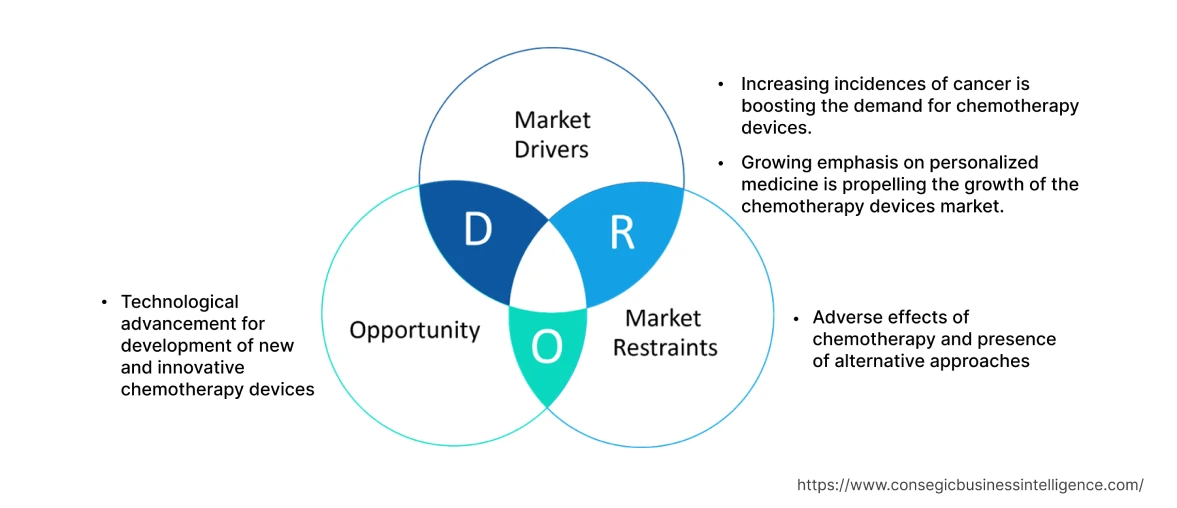
Key Restraints :
Adverse effects of chemotherapy and the presence of alternative approaches
Chemotherapy is associated with various side effects including hair loss, nausea, and fatigue, among others. These adverse side effects lead to discomfort and impact the patient's alternative treatment approaches. Moreover, the additional safety concerns as well as the risk of infection influence the adoption of devices. Further, analysis of market trends shows that the presence of alternative treatments such as targeted therapies, immunotherapies, and other approaches for cancer treatment is likely to hamper the chemotherapy devices market growth.
Future Opportunities :
Technological advancement for the development of new and innovative chemotherapy devices
Traditional infusion delivers fluids, such as nutrients and medications into a patient's body. However, the excessive resistance leads to the build-up of pressure and eventual failure of the syringe pump. The advancement in technology provides opportunities to the key players for the development of technologically enhanced infusion pumps that are anticipated to offer benefits such as improved accuracy, better precision, advanced digital data storage, and remote programming.
- For instance, in December 2022, Baxter International Inc. received clearance for the new Novum IQ syringe infusion pump (SYR) with Dose IQ Safety Software. The Novum IQ Syringe Infusion Pump can fully integrate with hospital electronic medical records (EMRs) through Baxter's IQ Enterprise Connectivity Suite.
Hence, market trends analysis shows that the growing development of advanced technology-based infusion pumps for chemotherapy treatment is expected to boost the chemotherapy device market opportunities.
Chemotherapy Devices Market Report Insights :
| Report Attributes | Report Details |
| Study Timeline | 2017-2030 |
| Market Size in 2030 | USD 20,807.56 Million |
| CAGR (2023-2030) | 7.1% |
| By Product | Catheter, Cannula, Pump (Large Volume Pump, Syringe Pump, and Elastomeric Pumps), and Others |
| By End-User | Hospital, Clinics, and Others |
| By Region | North America, Europe, Asia-Pacific, Latin America, and Middle East & Africa |
| Key Players | BD, Micrel Medical Devices SA, B. Braun SE, ICU Medical, Inc., Moog Inc., ZynoMed, Terumo Corporation, Baxter International Inc., Fresenius SE & Co. KGaA, and Mindray Medical India Pvt. Ltd. |
Chemotherapy Devices Market Segmental Analysis :
By Product :
The product segment is categorized into catheter, cannula, pump, and others.
In 2022, the pump segment accounted for the highest market share of 39.28% in the overall chemotherapy devices market share. The pump segment is further classified into large-volume pumps, syringe pumps, and elastomeric pumps. Chemotherapy Pumps deliver fluids such as nutrients and medications into a patient body in controlled amounts. Also, chemotherapy pumps are widely used in clinical settings such as nursing homes, hospitals, and home care which drives the chemotherapy devices market demand.
However, the catheter segment is expected to be the fastest-growing segment in the market during the forecast period as it is used to give intravenous fluids, blood transfusions, and other drugs. Further, a catheter is widely used to reduce the risk of drug leakage outside a vein, helps to avoid bleeding problems and a low platelet count, and reduces the need for repeated needle sticks.
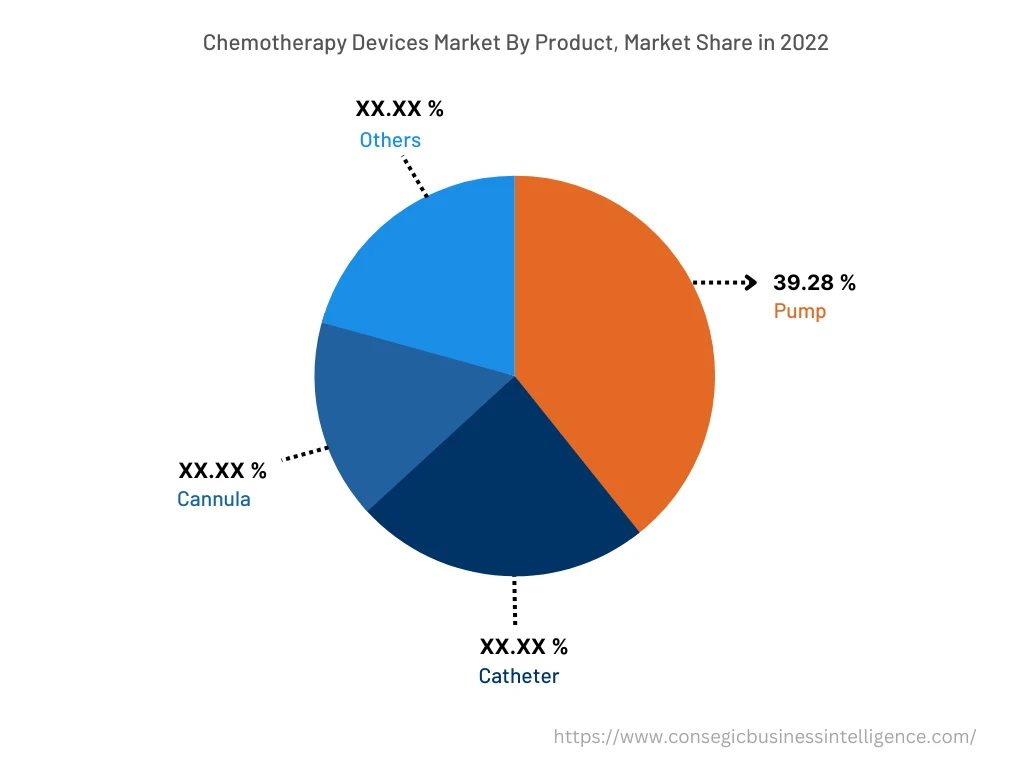
By End-User :
The end-user segment is classified into hospitals, clinics, and others.
In 2022, the hospital segment accounted for the highest market share and is also expected to grow at the fastest CAGR over the forecast period in the chemotherapy devices market. This is due to the rising cases of cancer, and the adoption of advanced chemotherapy devices in hospitals to ensure the proper chemotherapy treatments. Hence, segmental trends analysis depicts that the rising cases of lung cancers are driving the need for devices to provide treatment to cure cancer, boosting the chemotherapy devices market trends.
By Region :
The regional segment includes North America, Europe, Asia Pacific, the Middle East and Africa, and Latin America.
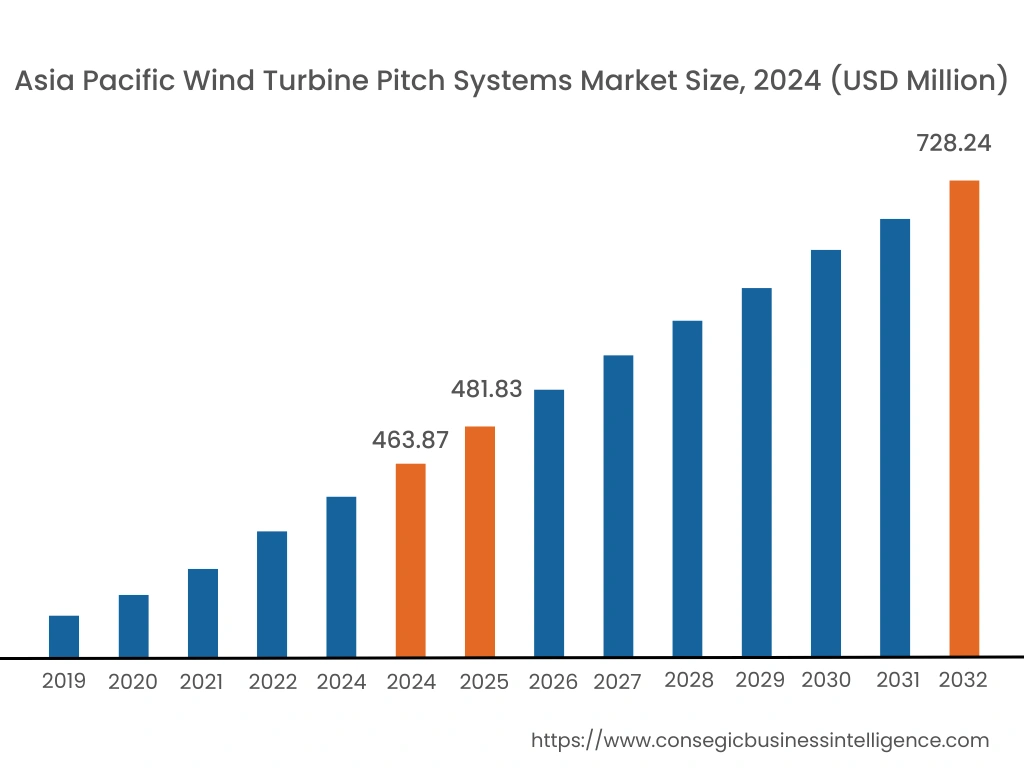
In 2022, North America accounted for the highest market share at 42.78% valued at USD 5,193.34 million, and is expected to reach USD 8,668.43 million in 2030. In North America, the U.S. accounted for the highest market share of 88.21% during the base year 2022 owing to the increasing growth of advanced health technologies and rising private players' investments in the development of hospitals. Further, as per the chemotherapy devices market analysis, the increasing prevalence of cancer particularly in the U.S. is driving the chemotherapy devices market trends.
- For instance, according to the U.S. Department of Health and Human Services, in 2020, an estimated 1,806,590 new cases of cancer will be diagnosed in the United States hospital.
Moreover, Asia Pacific is expected to grow at the fastest CAGR of 7.8% during the forecast period due to the increasing government initiatives for refining chemotherapy treatment, the development of new hospital facilities, and the increasing investment in healthcare sectors in countries such as China and India. Thus, the regional trends analysis shows that the aforementioned factors drive the chemotherapy devices market expansion.
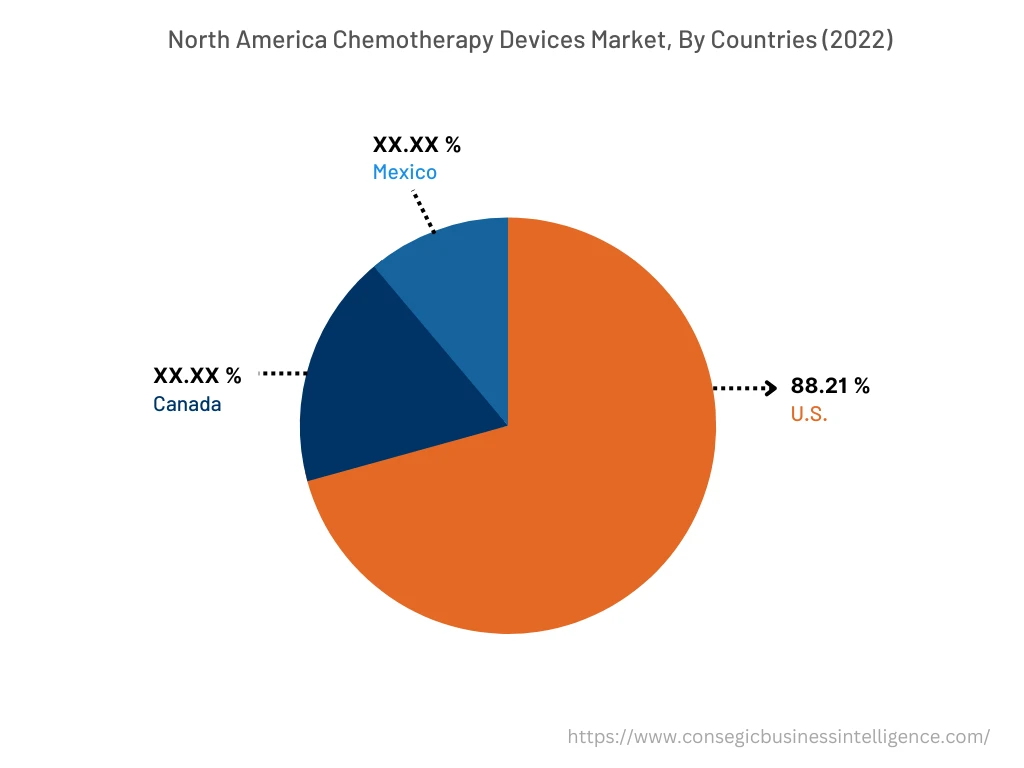
Top Key Players & Market Share Insights:
The global chemotherapy devices market is highly competitive, with several large players and numerous small and medium-sized enterprises. These companies have strong research and development capabilities and a strong presence in the market through their extensive product portfolios and distribution networks. The chemotherapy devices market is characterized by intense competition, with companies focusing on expanding their product offerings and increasing their market share through mergers, acquisitions, and partnerships. The key players in the chemotherapy devices industry include -
- BD
- Micrel Medical Devices SA
- B. Braun SE
- ICU Medical, Inc.
- Moog Inc.
- ZynoMed
- Terumo Corporation
- Baxter International Inc.
- Fresenius SE & Co. KGaA
- Mindray Medical India Pvt. Ltd.
Recent Industry Developments :
- In December 2022, Terumo Corporation announced the launch of "G-Lasta Subcutaneous Injection 3.6 mg BodyPod", a drug-device combination product that is co-developed with the help of Kyowa Kirin Co., Ltd.
- In May 2021, Becton, Dickinson, and Company announced the launch of an IVD immune assay application called BD Multitest 6-Color TBNK Reagent with BD Trucount Tubes.
Key Questions Answered in the Report
What was the market size of the chemotherapy devices market in 2022? +
In 2022, the market size of chemotherapy devices was USD 12,139.65 million.
What will be the potential market valuation for the chemotherapy devices market by 2030? +
In 2030, the market size of chemotherapy devices will be expected to reach USD 20,807.56 million.
What are the key factors driving the growth of the chemotherapy devices market? +
Increasing incidences of cancer and growing emphasis on personalized medicine are the key factors driving the growth of the chemotherapy devices market.
What is the dominating segment in the chemotherapy devices market by product? +
In 2022, the pump segment accounted for the highest market share of 39.28% in the overall chemotherapy devices market.
Based on current market trends and future predictions, which geographical region will have the fastest impact on the chemotherapy devices market's growth in the coming years? +
Asia Pacific is expected to be the fastest-growing region in the market during the forecast period.
